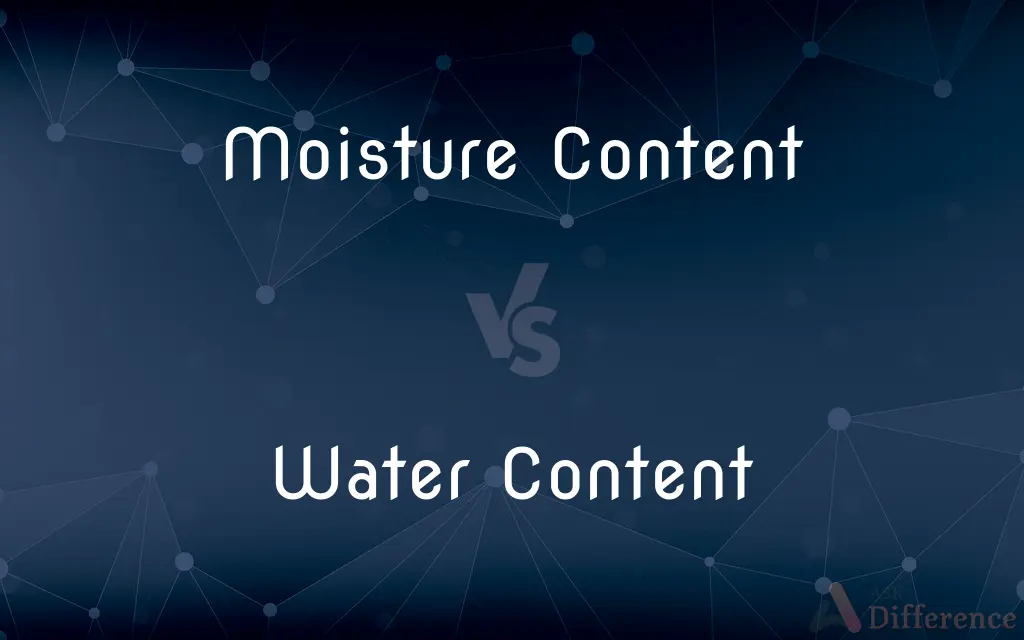Moisture Content vs. Water Content — What's the Difference?
Edited by Tayyaba Rehman — By Maham Liaqat — Published on March 7, 2024
Moisture content refers to the total amount of water in a material, including surface and bound water, while water content specifically measures the volume or weight of water in a substance.

Difference Between Moisture Content and Water Content
Table of Contents
ADVERTISEMENT
Key Differences
Moisture content is a broader term that encompasses all forms of water present in a substance, including water that is absorbed, adsorbed, or chemically bound within the material. This measurement is crucial in various industries to ensure product quality and durability. Water content, on the other hand, usually refers to the free water present in a substance that can be removed by drying under specified conditions. It is a critical parameter in fields such as soil science, where it influences soil properties and plant growth.
While moisture content is often expressed as a percentage of the total weight of a material, indicating the proportion of water it contains, water content may be presented in similar terms or as a volume measurement, depending on the context and industry standards. Conversely, water content measurements are pivotal in agriculture for irrigation planning and in geotechnical engineering for assessing soil compaction and strength.
The methods used to measure moisture content can vary, ranging from oven drying to sophisticated instrumental techniques like Karl Fischer titration, which can distinguish between different types of water in a sample. Water content measurements, however, often involve simpler drying methods or the use of equipment like TDR (Time Domain Reflectometry) probes in soil, focusing on the total water volume without differentiating its forms.
Understanding the difference between moisture content and water content is vital for applying the correct measurement technique and interpretation of results in specific applications. For example, in wood processing, moisture content affects the wood's strength, dimensional stability, and resistance to biological degradation, while in soil science, water content affects aeration, permeability, and nutrient availability.
Both moisture content and water content are critical in environmental science to monitor water cycles and in hydrology to understand the movement and distribution of water in the environment. However, the choice between measuring moisture content or water content depends on the nature of the material, the purpose of the measurement, and the required precision and accuracy.
ADVERTISEMENT
Comparison Chart
Definition
Total amount of water in a material, including all forms.
Volume or weight of free water in a substance.
Includes
Bound, absorbed, and adsorbed water.
Primarily free water, excluding chemically bound water.
Measurement Units
Percentage of the total weight or volume.
Percentage or volume, depending on the context.
Significance
Critical for product quality, spoilage prevention, and durability.
Important for understanding soil properties, irrigation planning.
Measurement Methods
Oven drying, Karl Fischer titration, etc.
Drying methods, TDR probes, etc.
Application Fields
Food industry, construction, wood processing.
Agriculture, geotechnical engineering, soil science.
Impact
Affects durability, spoilage, and quality.
Influences soil compaction, strength, aeration.
Interpretation
Indicates overall water presence, including non-removable forms.
Focuses on removable water content
Compare with Definitions
Moisture Content
Often expressed as a percentage of the material's total weight.
A loaf of bread with a moisture content of 40% has 40 grams of water per 100 grams of bread.
Water Content
Affects the physical properties of materials such as soil and concrete.
Water content in concrete influences its curing time and final strength.
Moisture Content
Can vary widely depending on the material and its environmental exposure.
The moisture content of soil fluctuates with rainfall and evaporation patterns.
Water Content
The volume or weight of water contained in a substance, focusing on free water.
The water content of soil refers to the water that fills the spaces between soil particles and can be easily drained.
Moisture Content
Indicates the material's condition and suitability for use or storage.
High moisture content in grains can lead to spoilage and loss of quality.
Water Content
Important in fields like agriculture, hydrology, and environmental science.
Monitoring water content in watersheds helps in managing water resources and predicting droughts.
Moisture Content
The total amount of water in a material, encompassing all forms.
The moisture content of freshly cut wood includes both the water in its cells and the water bound to its fibers.
Water Content
Can be determined through methods like oven drying or using specialized equipment.
Soil water content is measured using TDR probes that detect the moisture level within the soil.
Moisture Content
Critical in industries where water content affects product quality and storage.
In the pharmaceutical industry, moisture content is controlled to ensure drug stability and efficacy.
Water Content
Essential for managing irrigation in agriculture and assessing soil health.
Optimal water content in soil ensures adequate hydration for crops without waterlogging.
Common Curiosities
What industries rely on water content measurements?
Agriculture, geotechnical engineering, and soil science heavily rely on water content measurements for various applications.
What is moisture content?
Moisture content refers to the total amount of water in a material, including bound and free water.
How is water content different from moisture content?
Water content specifically measures the free water in a substance, excluding bound or chemically attached water.
Why is moisture content important?
It is crucial for determining the quality, storage stability, and usability of various products.
Can moisture content affect the physical properties of materials?
Yes, it can significantly affect properties like strength, durability, and resistance to degradation.
Is moisture content relevant in environmental studies?
Yes, it helps in understanding water cycles, hydrology, and environmental moisture dynamics.
What factors influence moisture content in materials?
Environmental conditions, material composition, and exposure to water sources.
How are moisture content and water content measured?
Through methods like oven drying, Karl Fischer titration for moisture content, and TDR probes for water content.
What role does water content play in agriculture?
It is crucial for irrigation planning, ensuring soil health, and optimizing crop growth.
How does water content affect soil compaction and strength?
Optimal water content is essential for achieving desired soil compaction and strength in construction and agriculture.
Why is controlling moisture content important in the food industry?
To prevent spoilage, maintain quality, and ensure safety.
What is the significance of moisture content in wood processing?
It affects wood's dimensional stability, strength, and resistance to biological attack.
How does the choice of measurement (moisture vs. water content) affect analysis?
The choice depends on the material's nature and the purpose, affecting the precision and relevance of the data.
Can water content influence environmental monitoring and management?
Yes, it is key to managing water resources, predicting environmental changes, and ensuring ecosystem health.
Can water content measurements predict soil fertility?
Indirectly, as optimal water content is vital for nutrient availability and root development.
Share Your Discovery

Previous Comparison
Jake Brake vs. Exhaust Brake
Next Comparison
DPBS vs. PBSAuthor Spotlight
Written by
Maham LiaqatEdited by
Tayyaba RehmanTayyaba Rehman is a distinguished writer, currently serving as a primary contributor to askdifference.com. As a researcher in semantics and etymology, Tayyaba's passion for the complexity of languages and their distinctions has found a perfect home on the platform. Tayyaba delves into the intricacies of language, distinguishing between commonly confused words and phrases, thereby providing clarity for readers worldwide.













































